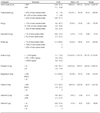1. Makarewicz-Wujec M, Kozłowska-Wojciechowska M, Sygnowska E, Waśkiewicz A. Does heart failure determine the nutrition of patients? Kardiol Polska. 2013; 72(1):56–63.
2. Lennie TA, Moser D, Biddle MJ, Welsh D, Bruckner GG, Thomas DT. Nutrition intervention to decrease symptoms in patients with advanced heart failure. Res Nurs Health. 2013; 36(2):120–145.
3. Obisesan TO, Toth MJ, Donaldson K, Gottlieb SS, Fisher ML, Vaitekevicius P. Energy expenditure and symptom severity in men with heart failure. Am J Cardiol. 1996; 77(14):1250–1252.
4. Pasini E, Opasich C, Pastoris O, Aquilani R. Inadequate nutritional intake for daily life activity of clinically stable patients with chronic heart failure. Am J Cardiol. 2004; 93(8A):41A–43A.
5. Lourenço BH, Vieira LP, Macedo A, Nakasato M, Marucci MDFN, Bocchi EA. Nutritional status and adequacy of energy and nutrient intakes among heart failure patients. Arq Bras Cardiol. 2009; 93(5):541–548.
6. Hughes CM, Woodside JV, McGartland C, Roberts MJ, Nicholls DP, McKeown PP. Nutritional intake and oxidative stress in chronic heart failure. Nutr Metab Cardiovasc Dis. 2012; 22(4):376–382.
7. Price RJ, Witham MD, McMurdo ME. Defining the nutritional status and dietary intake of older heart failure patients. Eur J Cardiovasc Nurs. 2007; 6(3):178–183.
8. Aquilani R, Opasich C, Verri M, Boschi F, Febo O, Pasini E. Is nutritional intake adequate in chronic heart failure patients? J Am Coll Cardiol. 2003; 42(7):1218–1223.
9. Lee H, Kang B, Chung HK, Do HJ, Shim JS, Bae SH. The assessment for nutrient intakes of Korean patients with heart failure. Korean J Nutr. 2010; 43(3):224–232.
10. Bonilla-Palomas JL, Gámez-López AL, Anguita-Sánchez MP, Castillo-Domínguez JC, García-Fuertes D, Crespin-Crespin M, et al. Impact of malnutrition on long-term mortality in hospitalized patients with heart failure. Rev Esp Cardiol. 2011; 64(9):752–758.
11. Narumi T, Arimoto T, Funayama A, Kadowaki S, Otaki Y, Nishiyama S. The prognostic importance of objective nutritional indexes in patients with chronic heart failure. J Cardiol. 2013; 62(5):307–313.
12. Dunn SP, Bleske B, Dorsch M, Macaulay T, Van Tassell B, Vardeny O. Nutrition and heart failure: impact of drug therapies and management strategies. Nutr Clin Pract. 2009; 24(1):60–75.
13. Cooper HA, Dries DL, Davis CE, Shen YL, Domanski MJ. Diuretics and risk of arrhythmic death in patients with left ventricular dysfunction. Circulation. 1999; 100(12):1311–1315.
14. Dudek SG. Nutrition essentials for nursing practice. 7th ed. Lippincott Williams & Wilkins;2013.
15. Evangelista LS, Heber D, Li Z, Bowerman S, Hamilton MA, Fonarow GC. Reduced body weight and adiposity with a high-protein diet improves functional status, lipid profiles, glycemic control, and quality of life in patients with heart failure: a feasibility study. J Cardiovasc Nurs. 2009; 24(3):207.
16. Shimon H, Almog S, Vered Z, Seligmann H, Shefi M, Peleg E. Improved left ventricular function after thiamine supplementation in patients with congestive heart failure receiving long-term furosemide therapy. Am J Med. 1995; 98(5):485–490.
18. Cahalin LP, Mathier MA, Semigran MJ, Dec GW, DiSalvo TG. The six-minute walk test predicts peak oxygen uptake and survival in patients with advanced heart failure. Chest J. 1996; 110(2):325–332.
20. Woo MH, Woo KH, Kyun SI, Kim KH, Byeon TS. Food and culture in the age of globalization. Seoul: Hakmoonsa;2006.
21. Correia MI, Waitzberg DL. The impact of malnutrition on morbidity, mortality, length of hospital stay and costs evaluated through a multivariate model analysis. Clin Nutr. 2003; 22(3):235–239.
22. Trippel TD, Anker SD, von Haehling S. The role of micronutrients and macronutrients in patients hospitalized for heart failure. Heart Fail Clin. 2013; 9(3):345–357.
23. The Korean Nutrition Society. Dietary reference intakes for Koreans. Seoul: The Korean Nutrition Society;2010.
24. Lee H, Kang B, Chung HK, Do HJ, Shim JS, Bae SH. The assessment for nutrient intakes of Korean patients with heart failure. Korean J Nutr. 2010; 43(3):224–232.
25. Grossniklaus DA, O'Brien MC, Clark PC, Dunbar SB. Nutrient intake in heart failure patients. J Cardiovasc Nurs. 2008; 23(4):357.
26. Lennie TA. Nutritional recommendations for patients with heart failure. J Cardiovasc Nurs. 2006; 21(4):261–268.
27. Kenny AM, Boxer R, Walsh S, Hager WD, Raisz LG. Femoral bone mineral density in patients with heart failure. Osteoporos Int. 2006; 17(9):1420–1427.
28. Abou-Raya S, Abou-Raya A. Osteoporosis and congestive heart failure (CHF) in the elderly patient: double disease burden. Arch Gerontol Geriatr. 2009; 49(2):250–254.
29. Bettencourt P, Ferreira A, Dias P, Pimenta J, Friões F, Martins L. Predictors of prognosis in patients with stable mild to moderate heart failure. J Card Fail. 2000; 6(4):306–313.
30. Scognamiglio R, Testa A, Aquilani R, Dioguardi FS, Pasini E. Impairment in walking capacity and myocardial function in the elderly: is there a role for nonpharmacologic therapy with nutritional amino acid supplements? Am J Cardiol. 2008; 101(11A):78E–81E.






 PDF
PDF ePub
ePub Citation
Citation Print
Print




 XML Download
XML Download